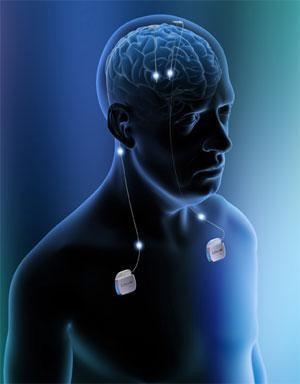This article will explore how Deep Brain Stimulation works, the conditions it treats, the procedure involved, potential benefits, and considerations for patients.
How Deep Brain Stimulation Works
DBS involves the implantation of a neurostimulator, similar to a pacemaker for the brain, which sends electrical impulses to targeted areas of the brain. The procedure typically includes:
- Electrode Placement:
Small electrodes are implanted into specific brain regions through a minor surgical procedure. These electrodes are connected to a pulse generator placed under the skin of the chest or abdomen. - Electrical Stimulation:
The pulse generator sends electrical impulses to the brain via the electrodes. These impulses modulate brain activity, helping to regulate abnormal signals that cause symptoms of neurological disorders. - Adjustable Settings:
The stimulation parameters can be adjusted non-invasively using a remote control device. This allows for personalized treatment tailored to the patient’s needs.
Conditions Treated with Deep Brain Stimulation
DBS is primarily used for managing symptoms of neurological disorders that are not adequately controlled by medication. The most common conditions treated with DBS include:
- Parkinson’s Disease:
DBS can help alleviate motor symptoms such as tremors, rigidity, and bradykinesia (slowness of movement) in patients with Parkinson’s disease, especially when medication is no longer effective or causes significant side effects. - Essential Tremor:
Essential tremor, a condition characterized by uncontrollable shaking, can be effectively managed with DBS. The stimulation helps to reduce the tremors and improve hand function. - Dystonia:
DBS can help treat dystonia, a movement disorder causing involuntary muscle contractions and abnormal postures. It can significantly reduce the severity of symptoms and improve overall quality of life. - Obsessive-Compulsive Disorder (OCD):
In some cases, DBS has been used for treatment-resistant OCD, helping to reduce the severity of compulsions and obsessions. - Epilepsy:
DBS may be considered for patients with epilepsy who have not responded to other treatments. It helps to reduce the frequency and severity of seizures.
The Deep Brain Stimulation Procedure
The DBS procedure is typically performed in two stages:
- Pre-Operative Evaluation:
Prior to surgery, patients undergo a thorough evaluation, including imaging studies such as MRI or CT scans, to determine the precise location for electrode placement. Neurological and psychological assessments are also conducted. - Surgical Implantation:
The surgery is generally performed under local anesthesia with sedation, allowing the patient to be awake during the procedure. This enables the surgical team to monitor brain activity and adjust electrode placement in real-time. The procedure involves:- Electrode Implantation:
Electrodes are carefully implanted into the targeted brain areas using stereotactic guidance, a precise method that uses 3D imaging to guide the placement. - Pulse Generator Placement:
A pulse generator is implanted under the skin, usually in the chest or abdomen. It is connected to the electrodes through insulated wires.
- Electrode Implantation:
- Post-Operative Care:
After surgery, patients are monitored for any complications. The device is programmed and adjusted based on individual needs. Follow-up visits are necessary to fine-tune the stimulation settings and ensure optimal results.
Benefits of Deep Brain Stimulation
Deep Brain Stimulation offers several advantages, including:
- Symptom Relief:
DBS can significantly reduce motor symptoms and improve function in patients with Parkinson’s disease, essential tremor, and dystonia. - Adjustable Therapy:
The ability to adjust stimulation settings allows for personalized treatment and optimization of symptom control. - Reversibility:
Unlike some other surgical interventions, DBS is reversible. If necessary, the system can be turned off or removed without permanent damage to brain tissue. - Improved Quality of Life:
Many patients experience substantial improvements in their ability to perform daily activities, leading to enhanced overall quality of life.
Considerations and Risks
While DBS has demonstrated significant benefits, it is not without risks. Potential complications include:
- Infection:
As with any surgical procedure, there is a risk of infection at the surgical site. - Bleeding:
There is a risk of bleeding within the brain, which could lead to additional complications. - Device-Related Issues:
Problems with the neurostimulator or electrodes can occur, potentially requiring device replacement or adjustment. - Cognitive and Mood Changes:
Some patients may experience changes in cognitive function or mood, although these are generally manageable and reversible. - Side Effects:
Possible side effects of stimulation include speech difficulties, balance problems, or skin irritation at the site of the implanted device.
Conclusion
Deep Brain Stimulation is a groundbreaking treatment that has transformed the management of various neurological disorders. By targeting specific brain areas with electrical impulses, DBS provides relief from debilitating symptoms and improves quality of life for many patients. While it involves a complex procedure and potential risks, the benefits often outweigh the drawbacks for those with treatment-resistant conditions. Consulting with a skilled neurologist or neurosurgeon can help determine if DBS is the right option for individual needs, leading to a more effective and tailored approach to managing neurological disorders.


